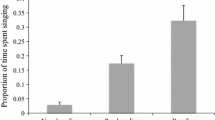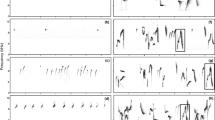Summary
We investigated how far competitive interactions influence the use of habitats and relative abundance of two species of Microtus in the southwestern Yukon. We worked in the ecotone between alpine tundra and subalpine shrub tundra where populations of singing voles (Microtus miurus) and tundra voles (M. oeconomus) overlap little.
We removed tundra voles from shrub tundra on one live-trapping area to look at the effect on the contiguous population of singing voles in alpine tundra. The removal of tundra voles did not affect the distribution or relative abundance of singing voles. The spatial distribution of these species and their movements within habitats suggest that they have a strong habitat preference.
Populations of small mammals in the area are extremely dynamic and the relative importance of competitive interactions may change as density varies. At present we have no evidence that competition affects habitat use in M. miurus.
Similar content being viewed by others
References
Banfield AWF (1974) The mammals of Canada. Univ of Toronto Press, Toronto
Birch LC (1979) The effect of species of animals which share common resources on one another's distribution and abundance. Fortschr Zool 25:197–221
Cole LC (1949) The measurement of interspecific association. Ecology 30:411–424
Colwell RK, Futuyma DJ (1971) On the measurement of niche breadth and overlap. Ecology 52:567–576
Connell JH (1975) Some mechanisms producing structure in natural communities. In: Ecology and evolution of communities, Cody and Diamond (eds.). Belknap Press, Harvard Univ Press Cambridge
Connell JH (1983) On the prevalence and relative importance of interspecific competition: evidence from field experiments. Am Nat 122:661–696
Douglass RJ (1976) Spatial interactions and microhabitat selections of two locally sympatric voles, Microtus montanus and Microtus pennsylvanicus. Ecology 57:346–352
Findley JS (1954) Competition as a possible factor in the distribution of Microtus. Ecology 35:418–420
Fretwell SD, Lucas HL (1970) On territorial behavior and other factors influencing habitat distribution in birds. I. Theoretical development. Acta Biotheriol 19:16–36
Getz LL (1963) A comparison of the water balance of the prairie and meadow voles. Ecology 44:202–207
Grant PR (1969) Experimental studies of competitive interaction in a two species system. I. Microtus and Clethrionomys species in enclosures. Can J Zool 47:1059–1082
Grant PR (1972) Interspecific competition among rodents. Ann Rev Ecol Syst 3:79–106
Grant PR (1978) Competition between species of small mammals. In: Populations of small Mammals under Natural Conditions, Snyder DP (ed) Pymatuning Lab Ecol Symposium Vol 5 Pittsburg, Pa:38–51
Guthrie RD (1971) Factors regulating the evolution of microtine tooth complexity. Sonderdruck aus Z. f. Säugetierkunde Bd. 36 H. 1, pp 37–54
Hawes DB (1976) Experimental studies of competiton among four species of voles. PhD thesis, Dept Zoology, UBC Vancouver
Hoefs M, McT.Cowan I, Krajina VJ (1975) Phytosociological analysis and synthesis of Sheep Mountain, southwest Yukon Territory, Canada. Syesis 8:125–228
Hurlbert SH (1969) A coefficient of interspecific association. Ecology 50:1–9
Iverson SL, Turner BN (1972) Winter coexistence of Clethrionomys gapperi and Microtus pennsylvanicus in a grassland habitat. Am Midl Nat 88:440–445
Koplin JR, Hoffman RS (1968) Habitat overlap and competitive exclusion in voles (Microtus). Am Midl Nat 80:494–507
Krebs CJ (1964) The lemming cycle at Baker Lake, Northwest Territories, during 1959–62. Arctic Institute of North America Tech Paper 15
Krebs CJ (1977) Competition between Microtus pennsylvanicus and Microtus ochrogaster. Am Midl Nat 97:42–49
Krebs CJ, Wingate I (1976) Small mammal communities of the Kluane Region, Yukon Territory. Can Field Nat 90:379–389
Levins R (1968) Evolution in changing environments. Princeton Univ Press, Princeton, NJ
MacArthur RH (1972) Geographical ecology. Harper and Row, NY
Merkt JR (1981) An experimental study of habitat selection by the deer mouse, Peromyscus maniculatus, on Mandarte Island, BC. Can J Zool 59:589–597
Morris RD (1969) Competitive exclusion between Microtus and Clethrionomys in the aspen parkland of Saskatchewan. J Mamm 50:291–301
Morris RD, Grant PR (1972) Experimental studies of competitive interaction in a two species system. IV. Microtus and Clethrionomys species in a single enclosure. J Anim Ecol 41:275–290
Mueller-Dombois D, Ellenberg H (1974) Aims and methods in vegetation ecology. John Wiley & Sons, NY
Murie JO (1971) Behavioral relationships between two sympatric voles (Microtus): relevance to habitat segregation. J Mamm 52:181–186
Randall JA (1978) Behavioral mechanisms of habitat segregation between sympatric species of Microtus: habitat preference and interspecific dominance. Behav Ecol Sociobiol 3:187–202
Ratliff RD (1982) A correction of Cole's C7 and Hurlbert's C8 coefficients of interspecific association. Ecology 63:1605–1606
Schoener TW (1983) Field experiments on interspecific competition. Am Nat 122:240–285
Southwood TRE (1978) Ecological methods. 2nd ed Chapman and Hall, London
Stoecker RE (1972) Competitive relations between sympatric populations of voles (Microtus montanus and M. pennsylvanicus). J Anim Ecol 41:311–329
Taitt MJ, Krebs CJ (1985) Population dynamics and cycles. In: Biology of New World Microtus. Tamarin RH (ed) (In press)
Turner BN, Perrin MR, Iverson SL (1975) Winter coexistence of voles in spruce forest: relevance of seasonal changes in aggression. Can J Zool 53:1004–1011
Youngman PM (1975) Mammals of the Yukon territory. Nat Museums of Canada, Publs Zoology 10
Author information
Authors and Affiliations
Rights and permissions
About this article
Cite this article
Galindo, C., Krebs, C.J. Habitat use by singing voles and tundra voles in the southern Yukon. Oecologia 66, 430–436 (1985). https://doi.org/10.1007/BF00378311
Received:
Issue Date:
DOI: https://doi.org/10.1007/BF00378311




